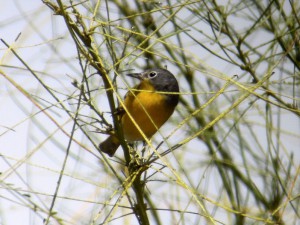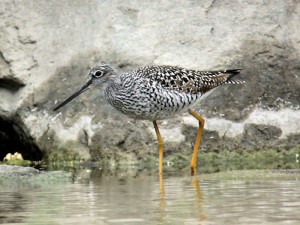We recently got the new Swarovski ATX-85 spotting scope in for evaluation and have really enjoying digiscoping birds with it. In addition to the crystal clear, tack sharp image quality, this scope also has a really well-designed digiscoping options for point-and-shoot cameras as well as micro 4/3 and standard DSLR cameras. Below are a few modest examples.
A Salton Sea Chase
We drove to the Salton Sea, looking for the recently reported Cave Swallows. There we found a group of Nashville Warblers playing in a palo verde tree, easily 70 yards away. In this case, the distance actually helped, as it gave us a few more seconds’ time to get one of these hyper-kinetic little birds in frame for long enough to snap off a shot or two. Most of the shots didn’t work out, primarily because of obscuring branches, but this one did. Now how often do you see people digiscoping a quick bird like a Nashville Warbler?! This picture was taken with a Nikon CoolPix P 300 camera, using Swarovski’s DCB II adaptor and the Swarovski ATX-85 spotting scope.
More Local Digiscoping
We chased a potential Solitary Sandpiper along San Diego Creek in Irvine early one morning. It was a very gray, overcast morning with a heavy marine layer, so there wasn’t much light available. We dipped on the Solitary but got this very handsome Greater Yellowlegs as compensation. We pushed the ISO setting on the Nikon CoolPix to 800 to stop the motion of this actively feeding bird. Thereafter, everything came pretty easily.



